There’s no doubt about it, marketing strategy is a must for your business. 🌟
❌ Without a defined strategy, your company risks compromising its development and sustainability (lack of vision, wasted resources, lost opportunities in the face of competition…).
So whether you’re about to launch it or want to improve your current marketing strategy, you’ll find everything you need to succeed in this guide. 🚀
➡️ On the program:
- Definition of a marketing strategy.
- Why develop a marketing strategy?
- The 7-step method for creating a successful marketing strategy.
- + 20 types of marketing strategies to use.
- 3 examples of successful marketing strategies: Google, LinkedIn and Waalaxy.
- Tools for marketing analytics and marketing automation.
We’re off! 🔥
What is a marketing strategy? Definition
A marketing strategy is an overall plan of actions developed by a company to promote its products/services to its target audience and achieve its business objectives. 🎯
Well-defined, it includes precise choices in terms of marketing segmentation, positioning and marketing mix to attract and retain customers. 🧲
Its aim is to strengthen brand awareness, maximize sales and ensure sustainable growth by adapting to market trends and consumer preferences.
🦾 In short, marketing strategy covers all the company’s efforts to establish its market position.
It’s usually conveyed in an official document so that all employees can read it and understand the company’s marketing strategy. 🤓
Why develop a marketing strategy?
🧱 Developing a marketing strategy is essential for identifying and reaching your target audience, differentiating your brand, optimizing resources, measuring the effectiveness of actions taken to achieve specific objectives and thus guaranteeing maximum return on investment.
It can be implemented to achieve corporate objectives, such as👇 :
- Increase sales.
- Acquire new customers.
- Increase sales with existing customers.
- Develop market share.
- Improve customer loyalty.
- Launch an advertising campaign.
Marketing strategy requires a number of steps, as well as adapting it to your offer or business sector. 🤔 That’s why there isn’t a standard strategy for every business, but the principle remains the same.
What is strategic marketing?
🔎 Strategic marketing means analyzing the market using various tools to define a long-term marketing strategy (and therefore the necessary actions) to position the company competitively.
Although marketing strategy is a long-term, it needs to be reviewed and updated regularly to further improve results.
Strategic marketing precedes operational marketing and enables :
- Guide the company towards attractive business opportunities,
- Anticipate market trends,
- Identify financial opportunities that match your resources and expertise.
- Steer actions to achieve sustainable growth.
👉🏼 In short, it means identifying the company’s mission, defining objectives and developing development strategies to ensure a balanced structure.
It’s a good idea to know exactly “what is marketing” and to have a definition of the main types of marketing (including the difference between a marketing strategic and operational) before getting started.
How do you create a marketing strategy?
As you can see, marketing strategies are essential to ensure the success of your marketing objectives (defined upstream) and your business goals. 🏆
🚀 By following these steps, you will be able to develop your marketing strategy and have all the cards in hand to achieve your marketing goals:
- Analyze the market and the competition.
- Good marketing targeting.
- Develop a marketing plan.
- Set up marketing actions.
- Know how to position your product/service.
- Monitor results.
- Adjust strategy.
1) Analyze the market and the competition
The success of a company’s marketing strategy depends primarily on the size of its market and the opportunities it presents. 👁️
Analysis can take the form of more or less in-depth market research (using PESTLE, Porter’s Forces, SWOT…), notably by analyzing: different customer segments, their sizes, external resources, etc. 📊
Thanks to this study, you’ll be able to approach the market and your audience with full knowledge of the facts, and then determine a coherent approach to entering or strengthening your position.
Then you’ll move on to the second part: competitor analysis (with a benchmark) to identify competitors’ strengths and weaknesses so you can adjust and differentiate your own marketing strategy from theirs. 👀
It also helps to anticipate market trends and adapt offers to achieve a sustainable competitive advantage (SCA).
You can carry out an SCA rating (by analyzing VRINS: Value, Rarity, Imitability, Non-substitutability) to rank them and find out whether your competitive advantages are sustainable compared to the competition (and which one is the most sustainable).
| SCA (your choice) | Value (V) | Rarity (R) | Imitability (I) | Non-substitutable (NS) | Total | Rank |
|---|---|---|---|---|---|---|
| Price | /5 | /5 | /5 | /5 | /20 | 1 |
| Quality | /5 | /5 | /5 | /5 | /20 | 3 |
| Support | /5 | /5 | /5 | /5 | /20 | 5 |
| Notoriety | /5 | /5 | /5 | /5 | /20 | 2 |
| Customer Exp. | /5 | /5 | /5 | /5 | /20 | 4 |
2) Target customers effectively
Once the market has been analyzed, it’s important to be able to find your audience and target them according to their needs.
👉🏼 To find your target customer, you need to target a group of people (beyond the product’s potential end-users) with similar consumption behaviors.
Even in this case, it’s important to remember that the same offer, product or service, can satisfy several groups of potential customers, some with different characteristics from others. 🌈
In this targeting process, we’ll need to match each objective or element of the offer to a “buyer persona” or “marketing persona”. 👤
Reminder: A buyer persona is a fictitious profile that includes the specific characteristics of each target: status, professional and/or personal situation, expectations, desires, tastes, purchasing power, consumer habits…

So, consider several potential customer segments and divide the market into similar subsets, or groups of consumers, with the same expectations and similar reactions). 🤗
To achieve this, you can leverage your current customers’ data (purchase history, interactions, profile) to identify them and refine your understanding of their needs.
✅ Finally, we advise you to choose segments that are large and profitable enough to justify investment, while aligning with your capabilities and offering.
3) Draw up a marketing plan
The marketing plan is an operational document and a guide to executing your marketing strategy (generally over 3 to 5 years). 📄
⚙️ Among the analyses that absolutely must be included: diagnostic conclusions, SWOT, strategic segmentation, defined marketing targeting, precise and detailed objectives…
In addition to these previous elements, it contains a roadmap for achieving the strategic objectives identified 🗺️ :
- It describes (what), plans (when), allocates (who) and budgets (how much), future marketing sales, communication and marketing actions or campaigns. For example with social media marketing plan or digital marketing plan.
- It also specifies how these actions are to be monitored, and the corrective measures to be taken if necessary. ✍️
👉🏼 In the end, the aim is to clearly determine the ideal positioning of the company and its offering, leading to a unique value proposition.
To ensure a coherent marketing approach to the market, the content of a marketing plan should be seen as structured between strategic and operational elements. 👐
Once you’ve defined your marketing plan, you can build on it to implement your marketing actions (some of which have already been detailed).
4) Set up marketing campaigns
Before implementing your marketing actions, you must first ensure that the objectives linked to each of them are SMART objectives (Specific, Measurable, Achievable, Realistic, Time-bound) to guide each strategic decision. ☄️
Next, you need to have defined and mastered the marketing mix (4P), i.e. your various marketing policies linked to the offer (helps simplify marketing decisions) 👇🏼 :
- Product: Meets the needs of the target market and offers unique value.
- Pricing: Set a pricing strategy that reflects perceived value, positioning and competition.
- Place: Choose the right distribution channels to maximize product accessibility.
- Promotion: Communication strategy (advertising, social networks, SEO) adapted to the audience.
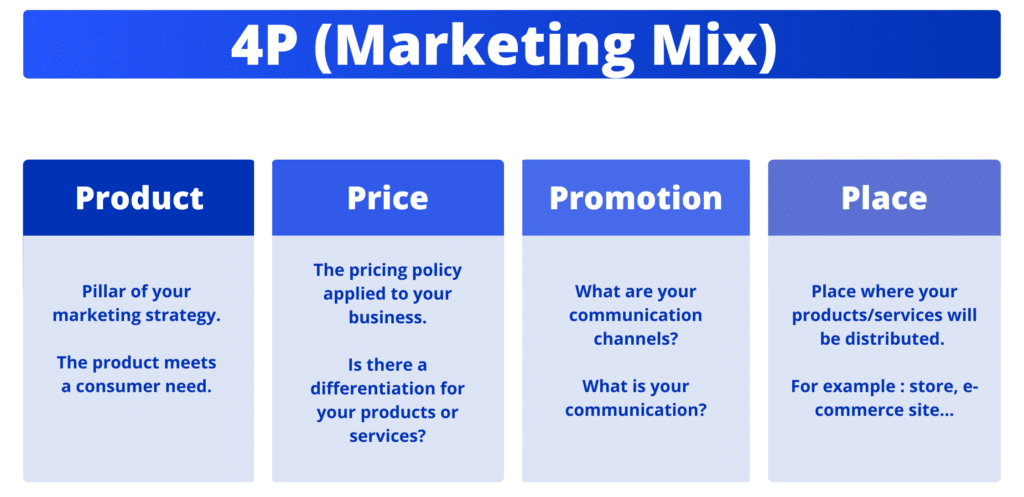
To increase the relevance and effectiveness of your offer and actions, customize them for each identified market and customer segment.
Finally, all you have to do is select the right customer acquisition channels (emailing, SEM, social networks, influencers), based on your target’s preferences and habits, but also on your budget. 💰
Depending on your business and the difficulty of acquisition or distribution, it may be appropriate to identify key players to market your product and assess their accessibility.
5) Know how to position your product
🗓️ Once you’ve planned all your marketing activities, it’s time to position yourself in relation to the competition and get your customers to adopt your value proposition.
As a reminder, there are several types of marketing and brand positioning to choose from based on your market analyses: leader, challenger, follower, specialist and niche. 📍
As a result, you can be the best performer (leader) or the cheapest (follower) in your market, but not the best performer AND the cheapest (it won’t work).
There are also many ways to position yourself in these different “roles” and gain competitive advantage, depending on the unique attributes of the offering, highlighted in the value proposition 💎 :
- By product attributes or characteristics,
- By benefits or needs,
- Through use or application,
- By users or competitors,
- By product category,
- By the quality/price ratio,
- By values or missions,
- Through innovation or customer experience.
Launching a product or service on a specific market means giving it a specific place in consumers’ minds compared with its competitors, so making it unique. 🌟
The value proposition must convince potential customers, and the advantages/benefits brought by the offering in response to their needs and expectations must be obvious. 🤩
To ensure that it is adopted, communication initiatives must be put in place.
The ideal? 📣 A content marketing strategy with the production of high value-added content and quality storytelling, to attract, engage audiences and reinforce your position.
6) Monitor and control results
This step is essential to ensure the success of your project. 😬
📊 Tracking and analyzing results, assessing the relevance of actions and regularly surveying consumers can be a source of new opportunities for the company.
How do you control your marketing activities? There are four steps to monitoring: 👇
- Evaluate the effectiveness of processes and the relevance of implemented actions.
- Check that targets are met.
- Compare the actual situation with the normal situation described in the plan.
- Examine and explain any discrepancies through comprehensive audits.
Monitoring often follows the same process, however the performance measures or conversion levers are different depending on the activity. 🧐 In digital marketing, we talk about bounce rate, website conversion rate, number of clicks, etc.
In addition to tracking sales and ROI, we need to ensure optimal distribution, monitor customer satisfaction, gauge brand popularity, etc . 😃
By integrating different KPIs, the company can discover new levers for improvement, elements to be optimized, and get closer to the market and customers to meet their needs.
A good understanding of the market enables us to measure the margin for progress and consider the actions needed to move forward. 🏃
7) Adapt and adjust your marketing strategy
💡 The market, like a company’s objectives, is constantly evolving. Market watch enables us to spot these trends, anticipate changes in offerings and adjust strategy as necessary.
If it turns out that marketing actions are not achieving the desired results, adjustments are then necessary. 🙏
🧪 To find out if this is the case, you need to do A/B testing and measure the gap between the results obtained and those expected :
| Little gap 🟢 | Reinforce the marketing plan with other actions or techniques (for example, inbound marketing to improve your brand image, build loyalty or attract new customers). |
| Large gap 🟠 | Reconsider the relevance of your actions, your objectives over time and/or the means to achieve them. |
| Very large gap 🔴 | Wrong strategies used due to poor analysis or sudden market changes. In this case, you’ll have to change your strategy completely, or abandon the project altogether. |
Depending on the situation, the company may consider new approaches, expanding into new markets (internationalization strategy), or collaborative branding actions. 🧨
That’s the end of this reference file to build your marketing strategy and adapted method. 🚀
At the end of the article, we’ll recommend some life-changing marketing automation tools like Waalaxy! 👽 But first, let’s take a look at the different marketing strategies.
What are the different types of marketing strategy?
As you can see, there isn’t just one type of marketing strategy… In fact, there are as many marketing strategies as there are companies. 🤯
It’s never easy to find your way around, and you’ll certainly be forced to change at some point…
We couldn’t present them all, but we have detailed more than 20 🔥 :
- We’ll start with Michael Porter’s 3 generic marketing strategies.
- Then we’ll move on to the 15 other marketing strategies we’ve selected because they’re widely used and will undoubtedly be very useful to you.
Generic marketing strategies
The generic marketing strategy is divided into three “sub-strategies”, aimed at establishing a competitive advantage for a company within a particular DAS.
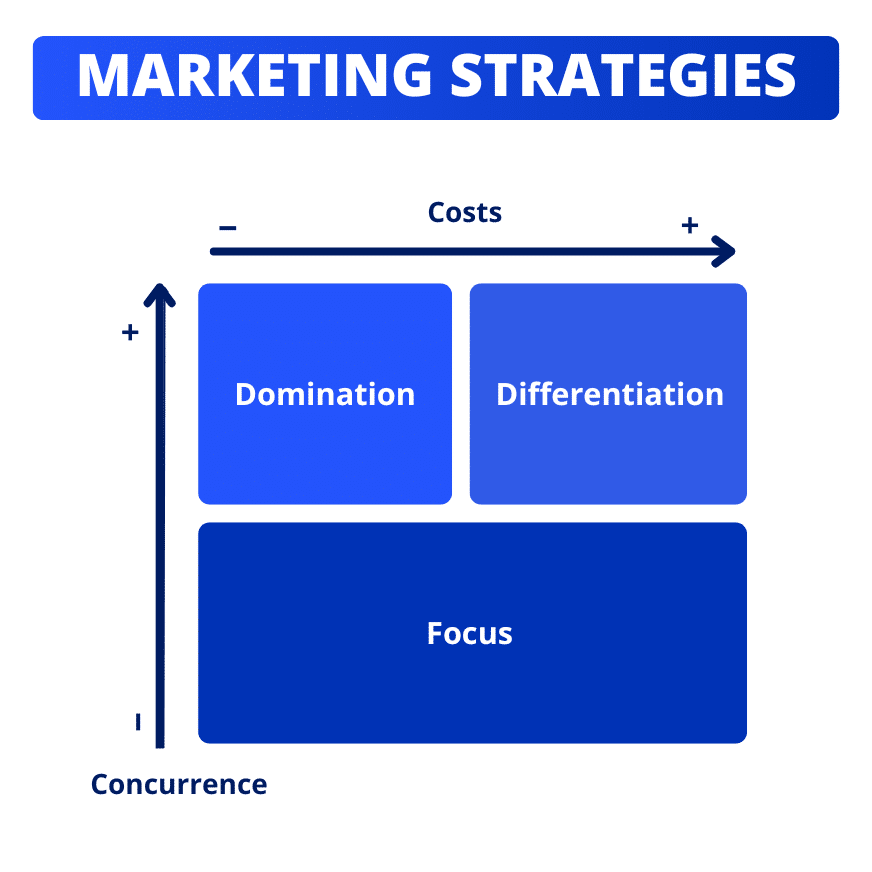
The Cost Domination Marketing Strategy
To implement a marketing strategy of dominance in a Strategic Business Unit (SBU/A), you need to find ways of reducing production costs on a large scale throughout the production chain, but without being imitated by the competition. 🤫
In this case, the surest way is to bring about innovation and market disruption to outperform competitors. The aim of this innovation is to significantly or slightly reduce unit prices and increase overall production with the same investment. 🌍
Therefore, you need to adapt your marketing mix and combine different marketing objectives depending on the DAS you want to specialize in! 🌟
Differentiation Marketing Strategy
The differentiation strategy develops by proposing offers that are totally different from the competition:
- Or through sophistication (luxury differentiation or “top-up”),
- Or by purification (or “bottom-up” differentiation). 🏹
For this kind of generic strategy to be appropriate, 🤑 companies need to offer products with a viable business model in terms of production volume and cost.
The target audience must have sufficient purchasing power for the strategy to be profitable. Market research enables us to measure commercial and strategic potential.
What’s more, you must always combine your marketing strategy with your operational strategy to ensure that your offer is consistent!
Focused Marketing Strategy
This generic strategy, known as focusing (or concentration, or skimming strategy), involves concentrating on products offered in very narrow market segments where companies are certain to outperform the competition without conflict. 💥
To be a viable target, the segment must meet the following conditions: Measurable (easily identifiable), Accessible (easy to reach), Exploitable (not too many competitors in the market), Profitable (business development potential). 🏹
This should enable you to make a profit, despite an inherently tight market. This strategy is often confused with a niche marketing strategy. 💎
Now let’s take a look at how to choose the right marketing strategy, once your objectives have been clearly defined. I promise it’ll be easier than it sounds! 🎯
Other marketing strategies to know
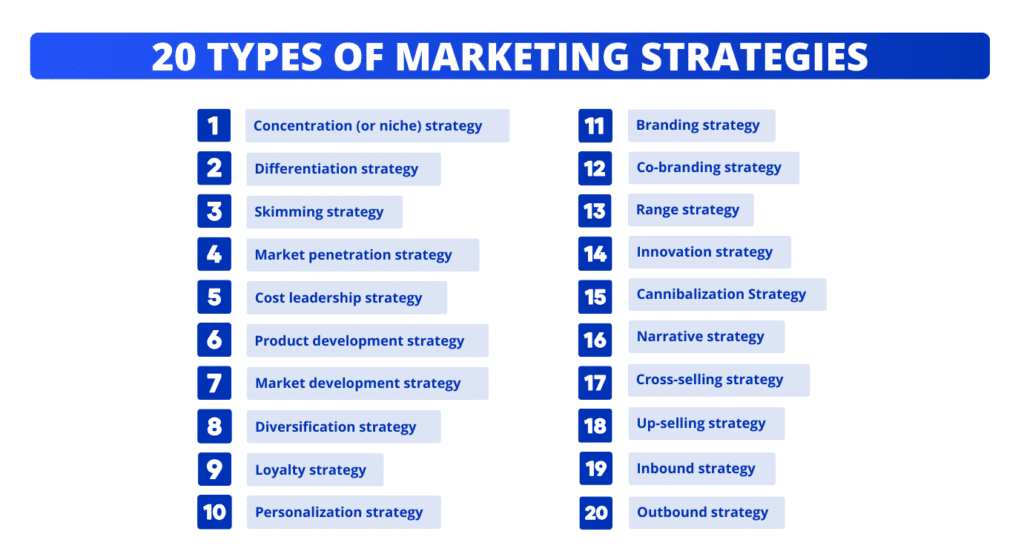
👇🏼 Here’s a table with an outline of the different types of marketing strategies (omnichannel or multichannel), including their definitions, associated objectives and examples of application:
| Name | Definition | Objectives | Example of use |
|---|---|---|---|
| Skimming strategy | Sell a product at a premium price to reach consumers willing to pay for novelty. | Maximized margins, perceived quality, rapid amortization of development costs. | High-tech launches (Apple, Samsung), premium marketing channels, exclusive boutiques. |
| Penetration strategy | Offer a low price to enter a market quickly and gain market share. | Rapidly increasing market share, discouraging competition. | FMCG products, promotions, TV commercials, social media platforms. |
| Product development strategy | Introduce new products to meet changing needs or expand an existing range. | Innovation, current customer loyalty, increased competitiveness. | Research & Development, surveys, product innovation (e.g. iPhone 14). |
| Market development strategy | Enter new geographic or demographic markets. | Sales expansion, revenue diversification. | International expansion, localized marketing, Google Ads for new markets. |
| Diversification strategy | Launch new products in new markets to reduce risks. | Risk reduction, new sources of income. | Conglomerates (Samsung, Virgin), co-branding, strategic partnerships. |
| Loyalty strategy | Maintain and develop relationships with existing customers to encourage them to return. | Lower customer costs, recurrent customers, higher LTV (Lifetime Value). | Loyalty programs, newsletters, CRM, e-mail marketing. |
| Personalization strategy | Observe, anticipate or stimulate the needs of each customer and adapt the offer to their needs and preferences. | Enhanced customer experience, increased loyalty, differentiation. | Personalized recommendations (Netflix, Amazon), CRM, e-mail marketing campaigns. |
| Branding strategy | Create a strong marketing strategy, memorable identity to distinguish the brand in the marketplace. | Brand recognition, differentiation, loyalty. | Logo, slogans, social networks, branding campaigns, video marketing, influencer marketing … |
| Co-branding strategy | Collaborate with another brand to reach new customers and strengthen image. | Cost sharing, synergies, greater visibility. | Partnerships (e.g. Nike and Apple), event marketing, co-branded products. |
| Range strategy | Offer a series of different but related products to cover different needs and segments. | Optimized sales, customer choice, increased loyalty. | Range extensions, product segmentation (e.g. Coca-Cola Light, zero). |
| Innovation strategy | Introduce new products or services to stay ahead of the competition. | Competitive advantage, enhanced image as an innovator. | R&D, product launches, innovation (Tesla, Dyson). |
| Cannibalization strategy | Introduce a new product that may reduce sales of an existing product of the same brand. | Market control, customer loyalty. | New models (iPhone, Galaxy), product updates. |
| Storytelling strategy | Use storytelling to create an emotional bond with consumers. | High commitment, loyalty, authentic brand image. | Videos, articles, social networks (Nike, Apple), billboards. |
| Cross-selling strategy | Offer complementary products to existing customers to increase basket value. | Increase sales, build loyalty. | Amazon «Customers who bought this also bought…», CRM, e-mail marketing. |
| Up-selling strategy | Encourage customers to buy a superior or more expensive version of the product. | Increased sales, improved customer experience. | E-commerce sites (upgrade proposals), CRM, in-store sales. |
| Inbound marketing strategy | Use content marketing to attract new leads. | Create a bond with prospects by offering them enriching type of content that matches their interests. | Social networks, blog, newsletter, lead magnet, public relations … |
| Outbound marketing strategy | Use untargeted, intrusive advertising (can be very costly and is only effective at the beginning of the sales tunnel). | Get more or fewer customers quickly. | Ads, display, pop-up, spam mail… |
💁🏻♀️ Of course, there are others, such as CRM marketing strategy!
Examples of best marketing strategies
📲 In recent years, marketing trends have changed the world of marketing, forcing professionals to integrate new approaches into their strategies.
To make things clearer, here are a few examples of effective marketing strategies to inspire you as you develop your business. 🏆
Effective marketing strategy #1 : Google
⌨️ Google is a model of successful marketing strategy, and has built its success on technological innovation, user-centricity and service diversification.

Its marketing strategy is based on a flagship product: THE search engine, which attracts billions of users worldwide every day (8.5 billion searches per day). 🤯
🤖 By constantly optimizing the user experience with powerful, relevant algorithms, Google has built user loyalty and established a Sustainable Competitive Advantage (SCA).
But Google didn’t stop there, and diversified with :
- 📲 An expanded ecosystem of complementary services and applications (Gmail, Google Maps, YouTube, Google Drive, Google Translate…), creating an integrated environment that covers all everyday needs.
- 📣 A position in the mobile device and cloud advertising sectors thanks to a data monetization strategy via Google Ads (targeting users according to their searches and interests).
Today, thanks to these two strategies, Google dominates the digital market and offers a complete range of interconnected services (sales of $307 billion). 💸
Effective marketing strategy #2 : LinkedIn
Another model of marketing tactic to follow: LinkedIn! 👤

The platform has successfully positioned itself among social media marketing and in the professional networking field, and has become THE must-have professional social network (+1 billion active users worldwide 🌎).
How can we do this? By creating a community where users and businesses can interact, network, sell, recruit and promote their skills. 🔥 That’s all there is to it.
By focusing on a content strategy, LinkedIn encourages users to share their expertise, strengthening the platform’s commitment and credibility.
🦾 To further strengthen its position, it launched :
- The freemium model to attract new members with free features, while offering paid options (LinkedIn Premium, Sales Navigator, Lite Recruiter) for advanced access to prospecting and recruiting. 🤑
- Training tools, such as LinkedIn Learning, to improve user retention and reinforce the network’s added value. 📚
It is this integrated strategy, focused on content and engagement, that has enabled LinkedIn to grow rapidly and strengthen its leadership position.
Effective marketing strategy #3 : Waalaxy
👽 Waalaxy is our automated, multichannel sales prospecting tool (LinkedIn and Cold Email). Even if it’s not comparable to the two previous tools, we’ll tell you all about it.
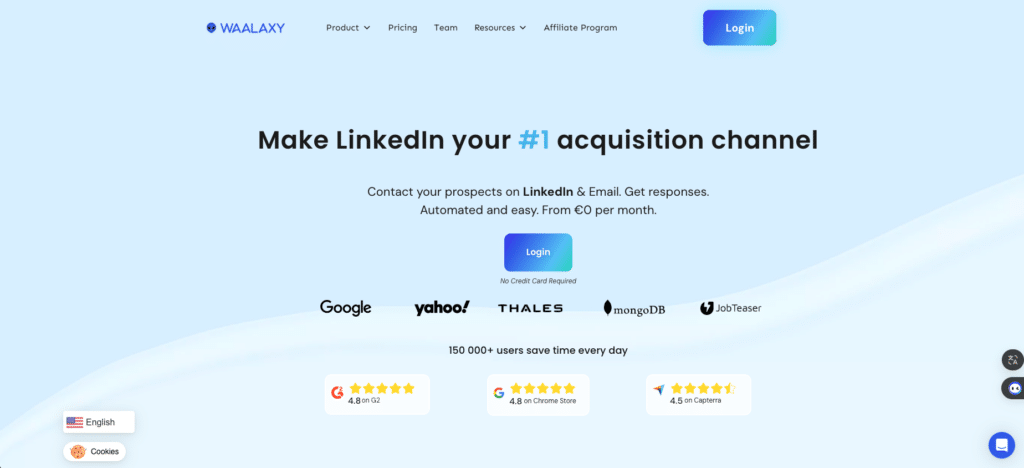
Despite its young existence, Waalaxy has deployed an effective marketing strategy that has enabled it to stand out and position itself as the market leader in automated prospecting (despite the huge competition on the market), thanks to its ease of use. 👌
The tool not only allows you to prospect, but also to develop your LinkedIn network and recruit, effortlessly. 😎 But, to become the best, we’ve staked everything on :
1️⃣ An educational approach with a blog rich in quality content, which has attracted a qualified audience as well as positioning the company as a reference for recruitment, marketing and digital prospecting.
2️⃣ An ultra-active community built on LinkedIn, encouraging company members to post and interacting regularly with users, which reinforced credibility, loyalty and commitment to Waalaxy.
3️⃣ The freemium model, offering a free version of our tool to attract new users, with the possibility of upgrading to paid offers to access advanced features (like LinkedIn).
By the way, we’d like to take this opportunity to tell you that you can integrate Waalaxy into your “marketing strategy. 🚨

✅ Here are the reasons to use it:
- Search and auto-import leads from LinkedIn.
- Cleaning and sorting of prospect lists before sending your Waalaxy campaigns.
- Profile visits, automatic invitations, messages and personalized e-mails to improve prospect engagement and increase conversion rates.
- Dashboard with sales KPIs and detailed analyses to evaluate campaign effectiveness.
- Integrates with popular CRM tools to facilitate prospect marketing management and follow-up.
- Ensures secure use by complying with platform and RGDP restrictions, avoiding the risk of sanctions.
- Save time by launching multichannel campaigns automatically, so you can optimize your overall marketing efforts and concentrate on higher value-added tasks.
Believe me, operational marketing software need to be part of your marketing strategy. And you really don’t want to miss out! 👇🏼
With Waalaxy, it’s increasingly possible to get the right message to the right person at the right time. 🌟
Conclusion – How to create effective marketing strategies?
To sum up, for an effective marketing strategy, it is essential to follow the key steps we have seen together:
1. In-depth analysis of the market and competitors, to understand the context and identify opportunities. 🔍
2. Define SMART goals indicators (clear and measurable) in line with the company’s vision, for accurate evaluation. 🎯
3. Strategically segment the market and choose the right target audience, building personas to better understand needs and expectations. 👤
Beware, even if you do everything right, but target the wrong people, all your marketing efforts will be in vain. 🙈
5. Create the marketing mix with the different policies (product, price, place, promotion), to develop an offer aligned with the needs of its audience. 💎
6. Selecting the right customer acquisition channels (social media strategy, SEO strategy, emailing…) to optimize campaign reach. 📣
7. Performance monitoring enables the strategy to be adjusted and improved to maximize efficiency and long-term results. 📊
Now it’s up to you to choose the right marketing strategy for yout business! 🔥
Frequently Asked Questions (FAQ)
What is SWOT?
⚙️ SWOT is a marketing tool that enables a global analysis of a company’s strengths and weaknesses (internal) and market opportunities and threats (external).
As the first step in your marketing strategy 🥇, the SWOT analysis enables you to guide your decisions, develop actions adapted to the internal and external context, evaluate available resources and limits…
So you need to list each part of the SWOT in a 4-box table. Here is an example to fill in. 👇
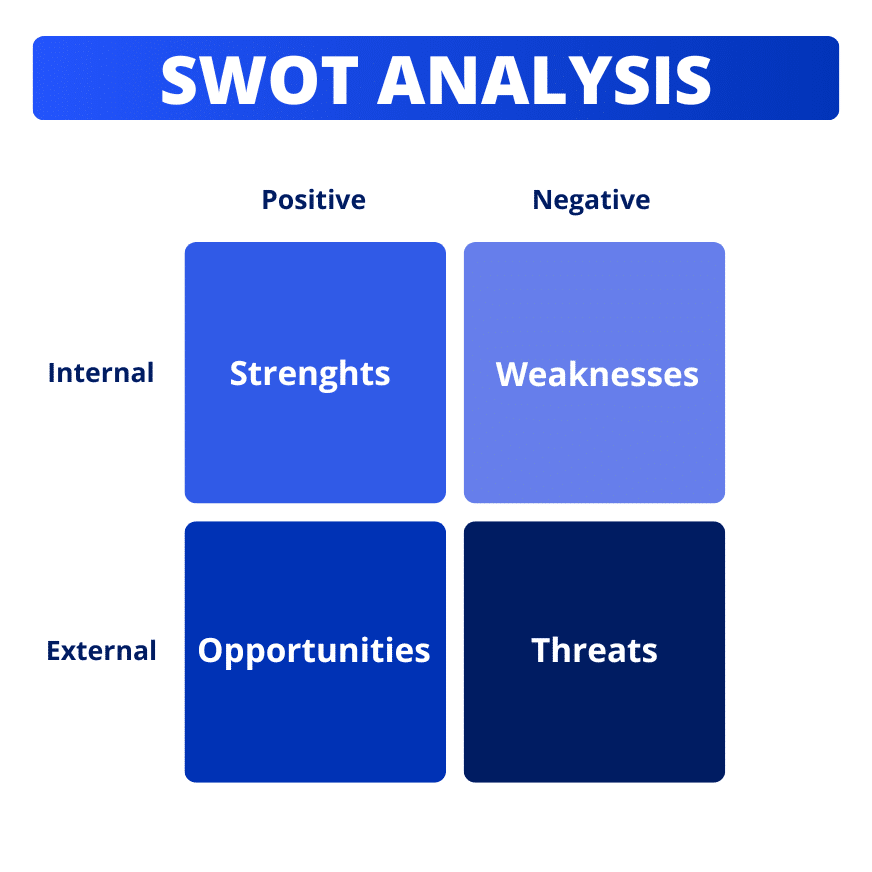
Once you’ve done the SWOT, you’ll have a better idea of the marketing project‘s potential. You can then build the persona and create the offer and message. ✅
Why use storytelling in your marketing strategy?
📖 Storytelling is now an important part of an effective marketing strategy.
Whatever market you want to position yourself in, there are always more competitors, so you need to differentiate yourself, and storytelling is a good way of doing this.
Storytelling aims to convey a message or values by telling a unique story (what inspired it, its founders etc…), which conveys your identity and in which the reader or target audience can identify. 💖
Using this common storytelling technique contributes to brand awareness and helps entice people to connect with your brand or company. 🤩
Storytelling is akin to copywriting and not only helps to attract and establish a close relationship with your customers, but also to strengthen your brand image and win the loyalty of potential customers! 💥
How do you create an operational marketing strategy?
5C operational marketing is a strategic segmentation aimed at improving the completeness of analysis and acting more effectively. ⚡
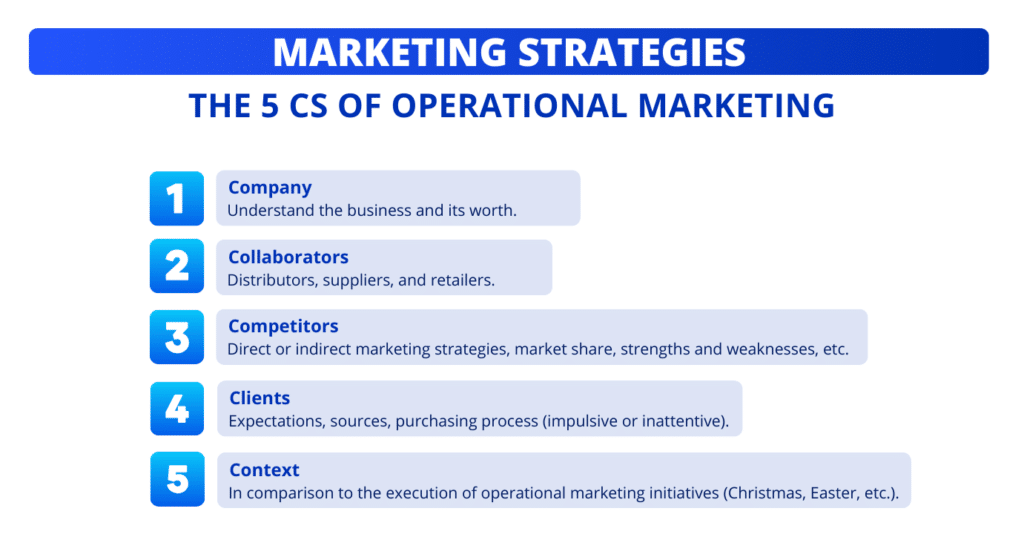
Just as with the marketing mix or 4 ps of marketing, 🙏 these 5Cs will help you create your marketing strategy and stay on track to be able to distinguish each strategic point more easily!
Operational marketing strategy is the « action » part. For example, the creation of marketing tools and marketing content (advertising, discussion, cold emailing, press releases, surveys, etc.). This is the embodiment of strategic marketing and the implementation of the marketing plan. 💪
That’s it, that’s the end of our article, and you know all about marketing strategy! See you soon!👽







